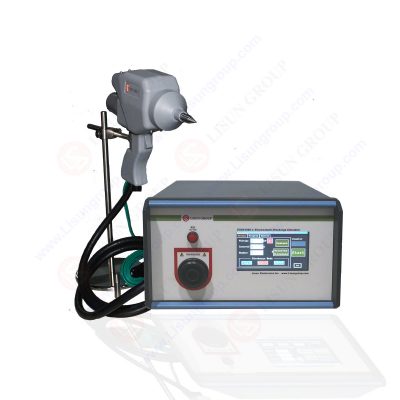

Introduction
Electrostatic discharge (ESD) is a critical factor in the design and testing of electronic equipment. The ESD test gun, a vital tool in the field of electromagnetic compatibility (EMC), simulates electrostatic discharges, helping engineers evaluate the resilience of devices against ESD-related damage. Among the leading products in this category is the LISUN ESD61000-2 ESD Simulator Gun, which adheres to the IEC 61000-4-2 standard. This article explores the features, applications, and performance of the ESD test gun, focusing on the LISUN ESD61000-2.
The Importance of ESD Testing
Electronic devices are prone to electrostatic discharges, which can occur during human handling, environmental interactions, or contact with other devices. ESD testing is crucial for ensuring that devices can withstand these discharges without suffering permanent damage or malfunctions. The ESD test gun is a primary instrument used to replicate these discharges in a controlled environment.
Key Features of LISUN ESD61000-2 ESD Simulator Guns
The LISUN ESD61000-2 ESD Simulator Gun is designed for testing electrostatic immunity in compliance with the IEC 61000-4-2 standard. Some of its notable features include:
• Voltage Range: The ESD gun offers a wide range of discharge voltages, from 0.2 kV to 30 kV, making it suitable for a variety of testing environments and equipment.
• Polarity Selection: Both positive and negative polarities can be tested, ensuring comprehensive analysis of equipment behavior under different ESD conditions.
• Contact and Air Discharge Modes: The gun can perform both contact and air discharge tests, making it adaptable to different testing needs. The contact discharge simulates ESD events that occur when a conductor touches another surface, while the air discharge simulates discharges through air gaps.
• Compliance with IEC 61000-4-2: This ensures that the ESD gun meets international standards for ESD immunity testing, making it a reliable tool for global applications.
Parameter
Specification
Voltage Range
0.2 kV – 30 kV
Polarity
Positive and Negative
Discharge Modes
Contact and Air Discharge
Standard Compliance
IEC 61000-4-2
Discharge Repetition Rate
0.1 Hz – 20 Hz
Power Supply
Internal Battery or External Power
ESD61000-2_Electrostatic Discharge Simulator
Applications of ESD Test Gun
The LISUN ESD61000-2 is widely used in industries where ESD can severely impact the functionality and reliability of electronic devices. Its applications include:
• Consumer Electronics: Ensuring that devices like smartphones, laptops, and tablets can withstand electrostatic discharge is essential for user safety and product longevity.
• Automotive Electronics: As vehicles become more reliant on electronic systems, ESD immunity becomes critical in ensuring that safety features like airbags, ABS systems, and infotainment systems remain functional in the face of ESD events.
• Medical Devices: Life-supporting devices and diagnostic equipment must maintain performance even when subjected to high-voltage ESD events.
• Telecommunication: Network equipment and devices must operate reliably under electrostatic disturbances to prevent data loss and communication breakdowns.
Working Principle of the ESD Simulator Gun
The ESD test gun works by generating a high-voltage pulse and discharging it onto the device under test (DUT). The process typically involves two modes of testing:
• Contact Discharge: The ESD gun touches the DUT directly to simulate a direct discharge of static electricity.
• Air Discharge: The gun discharges the pulse through air, simulating ESD events where there is a small gap between the source of the discharge and the DUT.
The ESD pulse generated by the gun can cause various reactions in the DUT, including temporary malfunctions, permanent damage, or no effect at all. The goal of ESD testing is to determine the voltage threshold at which the device experiences failure and to ensure that it can recover after experiencing ESD events.
Performance of LISUN ESD61000-2 in ESD Testing
In terms of performance, the LISUN ESD61000-2 offers high repeatability and precision in both contact and air discharge tests. Its wide voltage range ensures that the product can be used to test a variety of devices, from low-voltage consumer electronics to high-voltage industrial equipment.
Below is a table illustrating the typical performance of the LISUN ESD61000-2 in different discharge modes:
Test Type
Voltage Level (kV)
Test Mode
Result
Consumer Device
4 kV
Air Discharge
No effect on device performance
Automotive ECU
15 kV
Contact Discharge
Temporary reset observed, recovery in 10s
Medical Device
8 kV
Air Discharge
Device continues to function normally
Industrial PLC
20 kV
Contact Discharge
Malfunction, requires power reset
The results of these tests demonstrate the versatility and effectiveness of the LISUN ESD61000-2 in simulating real-world ESD conditions across various industries.
Advantages of LISUN ESD61000-2
The ESD test gun offers several advantages that make it a preferred choice for EMC testing labs and manufacturers:
• Portability: The LISUN ESD61000-2 is lightweight and portable, making it easy to transport between testing sites.
• Ease of Use: Its intuitive interface allows users to quickly set up and run tests without extensive training.
• Accuracy: The gun provides highly accurate and repeatable results, which is crucial for ensuring that devices meet industry standards.
• Cost-Effective: Compared to other high-end ESD guns, the LISUN ESD61000-2 offers a competitive price without compromising on performance.
Conclusion
In conclusion, the ESD test gun, particularly the LISUN ESD61000-2, is an indispensable tool in the testing and certification of electronic devices. Its adherence to international standards, wide voltage range, and ease of use make it a reliable choice for ensuring that electronic devices are protected against electrostatic discharges. Whether used in consumer electronics, automotive, medical, or industrial applications, the LISUN ESD61000-2 ensures that products meet the highest standards of ESD immunity.
By investing in comprehensive ESD testing with the LISUN ESD61000-2, manufacturers can ensure the longevity, reliability, and safety of their products, minimizing the risk of costly failures due to electrostatic discharge.
This article provides an in-depth look at the LISUN ESD61000-2 ESD Simulator Guns, highlighting its key features, applications, and performance in various test scenarios. https://www.lisungroup.com/news/technology-news/understanding-the-esd-test-gun-a-comprehensive-analysis-of-lisun-esd61000-2-esd-simulator-guns.html
.jpg)
Comments
Post a Comment